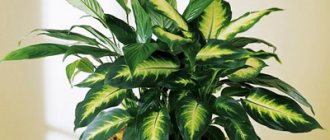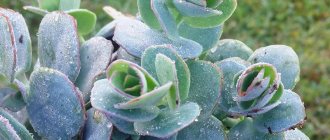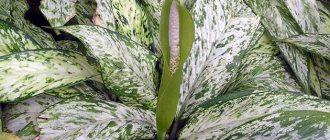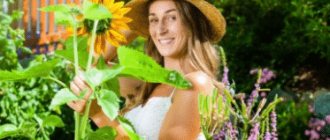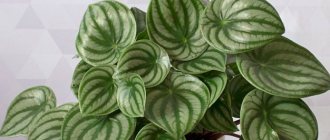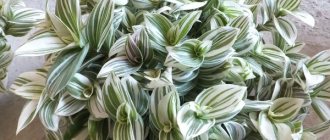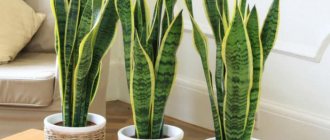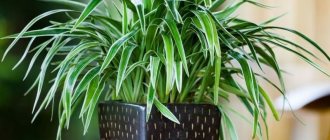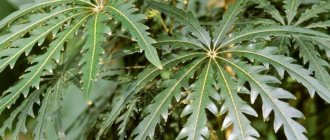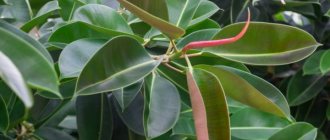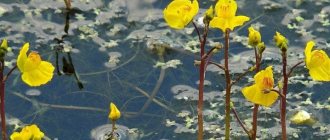- January 31, 2019
- Houseplants
- Marina Olenyuk
This spectacular flower is often used to decorate office spaces. It is found in government agencies, offices and even schools. There is an opinion that Dieffenbachia is a poisonous beauty. In this regard, a rather luxurious specimen may be sentenced to eternal expulsion from the apartment, even if until the moment of truth the owner loved and cherished the plant. Is it worth getting rid of it? Is the Dieffenbachia plant poisonous or are these just unfounded rumors? Right now you will learn some facts related to the benefits and harms of keeping a decorative leaf beauty in your home.
Popular speculation
Often, plants can be purchased based only on signs about them. A living tree is to improve the financial side of life, geranium is to ward off the evil eye, but the “heroine” of our article was immediately unlucky in this sense. Not yet knowing whether Dieffenbachia is poisonous or not, already unpleasant properties were attributed to it. The poor thing was called the flower of celibacy, endowing her with the ability to get rid of the owner in the room where she is. And if an unmarried lady decides to bring this flower into her apartment, seduced by its lovely wide leaves, then she will not find a soul mate forever and ever. Dieffenbachia is a poisonous “friend,” according to popular superstition; she will turn her owner into a divorcee or, worse, a widow in no time. Scary? But if you turn on prudence, you can remember more than one happy family that has the above-mentioned plant.
Superstitious people are very wary of the flowering of Dieffenbachia. As soon as she released the arrow, the owner of the house is deprived of his masculine strength, they think. Some go further and reinforce the horror story with the fact that if a couple has this flower and it suddenly puts out an ear, then the unfortunate people will not have children until they evict the innocent plant from the apartment.
Another legend is also associated with the flowering of Dieffenbachia. It is generally accepted that it occurs if there is a nervous atmosphere in the room. Frequent quarrels and scandals supposedly contribute to the appearance of a flower-cob. But these rumors have no scientific basis and are just popular speculation. A sane person understands that any plant blooms when external factors, similar to conditions in the wild, contribute to this.
Consequences of poisoning
Dieffenbachia intoxication can contribute to the development of complications. Contact of poison on the skin is usually limited to a local reaction and quickly passes with the correct assistance algorithm. Preventing skin burns is simple and involves wearing protective gloves.
A burn to the oral cavity causes more consequences. The mucous membrane contains many vessels, and one of the body’s protective reactions is to increase blood flow with the formation of edema. Localization of the burn can lead to difficulty breathing. Potential consequences are laryngitis with changes in voice timbre, inflammation of the bronchi, pneumonia. The condition is further aggravated by swelling of the nasal mucosa.
If Dieffenbachia juice gets into the eye, the prognosis for preserving vision and tissue restoration depends on the volume and speed of first and specialized medical care. Healing of the cornea may result in loss of transparency and the formation of a cataract.
Allergic reactions, even of a local nature, lead to the development of a terminal condition. You should not console yourself with the fact that several times the problem was resolved only by irritation of the skin or mucous membranes. The more such cases there are, the higher the possibility of developing an allergic reaction.
If in relation to adults one can count on caution and prudence, then for children the degree of risk remains high
Dieffenbachia is a poisonous plant that is often used as a decorative element in indoor design. Fans put forward more than one argument in favor of growing Dieffenbachia at home. For example, the ability to improve humidity and air composition, not only physical, but also energetic. However, the proven fact that the juice is poisonous outweighs the many beneficial properties of the plant. Dieffenbachia on contact causes burns to the skin, oral mucosa, eyes, and digestive upset.
Adults can exercise caution and follow simple rules of prevention, but responsibility for poisoning children lies with them. There are cases when children receive painful burns, gastrointestinal disorders when biting and swallowing leaves or stems of a plant.
When bringing a poisonous flower into the house, you should organize the life of the child and the Dieffenbachia so that they do not intersect or come into contact. Every adult must honestly answer the question whether it is possible to keep Dieffenbachia in his bedroom and whether the risk of harming the health of loved ones is justified, whether it is worth it to periodically admire the colorful leaves.
Poisonous plant Dieffenbachia
Description
The photos of the poisonous Dieffenbachia and its description given in the article will help you understand in general terms what kind of flower it is and why many, despite assumptions about its toxicity, still keep this beauty and love it very much.
The plant is native to the tropics of South America. More than forty species have been described by botanists to date. The assortment offered in flower shops makes it possible to acquire several different options. All Dieffenbachia are characterized by rapid development and growth. The beauty is in no hurry to bloom, and it is not very reasonable to expect gorgeous buds from it: all the beauty is in the leaves. The flower is a spadix with a light green covering leaf.
Varieties and varieties
The genus includes more than 60 species; below we will list only some of them used in indoor floriculture.
Dieffenbachia Bauze
Dieffenbachia Bause
has oval yellowish-green leaves up to 35 cm long. The leaf pattern is usually marbled, with white dots.
Dieffenbachia Oersted
Dieffenbachia Oersted
It has oval-pointed or elongated heart-shaped leaves up to 30−35 cm long, on which the central vein stands out. The leaf color is pure green, sometimes with small light spots.
Dieffenbachia spotted (Seguina)
Dieffenbachia spotted
This beauty from distant countries hid in the second tier of dense tropical forests, so spotted dieffenbachia is a bushy plant, its height is small, about 1 meter. The bush looks voluminous, lush and greatly decorates any space, be it an official institution or an ordinary city apartment.
The flower got its name from its leaves. Large, about 50 cm long, with sharp tips, they have a delightful coloring. It seems that nature itself used them as an artistic palette. On the dark background of the sheet plate, splashes, stripes, strokes, dots of white, yellow, light green are placed in artistic disorder, creating an incredibly beautiful picture. There may be 9-12 lateral veins on the surface of the leaf.
Dieffenbachia White Flame
Dieffenbachia White Flame
This new variety of Dieffenbachia is delicious. The leaves of the plant are glossy and elastic, their color reminiscent of the tongues of a blazing fire. The flower is not tall: from 60 to 70 cm in height. Like all Dieffenbachias, the plant loves light and warmth, but does not survive in a draft.
Dieffenbachia Charming
Dieffenbachia Charming
This Dieffenbachia differs from its relatives in the highly elongated shape of its leaves, the surface of which is glossy and dense. The coloring of the greenery of the “charming lady” is very original. On a dark green background, on both sides of the central vein, light straight lines drawn obliquely are densely located. From a distance, the simple pattern resembles a herringbone. Sometimes the picture has an abundance of small white dots, it seems that the plant is covered with light snow. For this, Dieffenbachia received its second romantic name - “Tropical Snow”.
Dieffenbachia baumann
Dieffenbachia baumann
This flower has the largest leaves of all Dieffenbachias: from 70 to 80 cm in length. The height of the plant is more than 1.5 m. It is loved by the owners of spacious apartments with high ceilings. Like many variegated Dieffenbachias, this specimen has whimsical light spots on dark leaves. The plant loves light and does not tolerate drafts at all.
Dieffenbachia Leopolda
Dieffenbachia Leopolda
This flower can rightfully be considered exotic in our country. It is rare among indoor plant lovers. The leaves of the plant have an unusual ellipse shape. In the middle of the green leaf, a clear and even white line stands out clearly, as if it was drawn along a ruler.
The leaves have a color of stunning beauty: an unusual contrasting transition from dark green to light milky color.
The trunk of the plant is short, no more than 5 cm in height, the cuttings are small, tightly pressed against the thick trunk.
For pets
Having learned whether Dieffenbachia is poisonous to people, let’s look at the situation with pets. Cats are very persistent in their desires, and if she decides to try this plant, rest assured, these cunning animals will get their way. When you're at home, you can ward off annoying foodies, but what happens when they're left alone? To avoid disaster, it is better to keep animals and Dieffenbachia in different rooms. Where the dangerous beauty will live, there is no place for curious four-legged creatures.
However, you should not fall into despair now, having discovered that that gorgeous flower that has been living with you for quite a decent time is nothing more than a poisonous Dieffenbachia. And at the same time, your beloved cat lives with you in the same rather modest living space. If he hasn’t touched the flower yet, then most likely he won’t do it.
Dogs can also taste Dieffenbachia, so it's worth taking safety precautions. The same goes for parrots. They can pinch off a piece of juicy greenery... For parrots, such a meal with a high degree of probability may be their last.
conclusions
Is Dieffenbachia harmful to people - the answer can be considered the saying “Forewarned is forearmed” - it is well suited to gardeners who decide to place a tropical plant with the unusual name “Dieffenbachia” in their home, because the benefits from it are much greater than the harm to health that can be reduced to a minimum by having the necessary information about the “pros” and “cons” of this evergreen exotic beauty.
Take action in time
What should you do if a drop of milky liquid gets on the skin of an adult who is not susceptible to allergies? Rinse the area with plenty of warm water as quickly as possible. You may be lucky and your body will not react violently to accidental contact. Under no circumstances should the juice come into contact with the mucous membranes. Eyes, nose, lips are very sensitive! After contact with eyes, the juice can cause blindness. In the other two cases, don’t expect anything favorable either.
If you feel dizzy or have headaches, call a doctor immediately. Difficulty breathing after contact with a plant or being close to it, confusion, difficulty speaking, and fainting are reasons to call the ambulance service.
With animals, if they have tasted the beauty, you need to do the same - urgently show it to a specialist. At the veterinary clinic, the doctor will provide the necessary assistance to your curious pet: he will rinse the stomach and prescribe further treatment.
Skin burn
The poisonous juice of Dieffenbachia comes into contact with unprotected tissues during processing of the plant, cutting off leaves, stems, and peduncles. Therefore, in order to avoid poisoning, any interaction with the flower must be carried out with gloves.
Symptoms will resemble a skin burn:
- acute pain;
- burning, itching;
- redness, swelling of the site of contact with the poison.
How to treat a skin burn from exposure to Dieffenbachia? It is enough to quickly wash off the juice with running water, including rinsing your mouth and nose. Do not rub the skin in an attempt to completely remove the aggressive substance. For severe pain, you can take a drug with an analgesic effect.
Benefits of Dieffenbachia
Despite all the dangers of the plant for people and animals, it is still loved and grown in apartments and other premises. This happens for some reason. First of all, the beauty of Dieffenbachia. Patterned bright leaves attract many gardeners. In addition to aesthetic pleasure, there is another good reason for growing the plant at home. The fact is that Dieffenbachia is an excellent indoor air purifier. Where there is at least one specimen of the plant, it is much easier to breathe. And here's why this happens:
- The presence of Dieffenbachia indoors reduces the level of formaldehyde in the environment. In addition to it, the plant absorbs a lot of dangerous fumes.
- There are significantly fewer pathogenic microbes in the air of the room where the beauty is located. Its phytoncidal properties are very valuable.
- The plant humidifies the air in the room well. Due to this, microscopic dust particles become heavier and a person inhales less of them.
Possible problems
Dieffenbachia withers
Drooping leaves are the first sign of plant dehydration. If the soil in the pot is dry, it is necessary to provide the flower with regular watering. Otherwise, you should check the substrate and root system of Dieffenbachia for the presence of rot and mold. If the roots of the plant rot, it is necessary to remove the bush from the pot along with the earthen lump. After this, you need to clean the soil from the roots and remove the damaged areas. The area of each cut should be treated with activated carbon or cinnamon powder. Dieffenbachia should be planted in new soil and the frequency of watering the plant should be adjusted correctly to reduce the risk of rot reoccurring.
Why do Dieffenbachia leaves dry out?
Typically, Dieffenbachia leaves dry out when the air humidity is insufficient, below 60%. At the same time, the plant weakens and becomes vulnerable to spider mite damage. Often the leaves dry out in a draft or cold.
Why does Dieffenbachia turn yellow?
Yellowing of leaves is caused by:
- insufficient lighting;
- excessive watering;
- high hardness of water for irrigation;
- burns after exposure of the leaf plate to direct sunlight.
If black bugs appear on Dieffenbachia
If the leaves of the plant lose their decorative appearance and become covered with dark spots, then thrips have infested them. Insect pests require repeated treatment of the plant with chemicals. It is necessary to spray Dieffenbachia regularly and cover it tightly with a bag. Treatment is repeated every 2 days. The total number of procedures varies from 6 to 7. After 10 days, the procedure should be repeated to kill thrips larvae.
Causes of leaf cracking
The cause of cracking of the Dieffenbachia trunk is the plant being affected by soft rot. Once such a disease appears, treatment is impossible. To save the bush, you can grow a new seedling from its top.
Sources and literature
An interesting feature of Dieffenbachia
The plant can “cry”. Transparent drops sometimes appear at the tips of Dieffenbachia, falling from the leaves especially intensely before rain. Other aroids have the same property, including philodendron and monstera. Sometimes a plant may “cry” after heavy watering. If you notice this, dry the soil and avoid frequent waterlogging. This can harm the plant: it will rot. Overmoistening is most dangerous during autumn and winter.
Home maintenance
Is it possible to keep and grow this flower at home?
Dieffenbachia does not tolerate drafts and temperature changes quite well. It is important to pay attention to this nuance when replanting the plant or ventilating the room in the cold season. At a certain period, it is necessary to give the plant the opportunity to rest, during which watering and fertilizing are reduced. As a rule, this is autumn-winter
As a rule, this is autumn-winter.
During the rest of the time, you can safely replant the flower (usually the plant needs it once every 2 or 4 years, as it grows). Drainage (expanded clay or small pebbles) is placed in the bottom of the container with Dieffenbachia. It will not be superfluous to loosen the soil from time to time and feed the plant with mineral fertilizers.
Problems and diseases
Due to improper care, the plant may experience certain problems. Such as yellowed leaves, the appearance of spots on them, the appearance of parasites.
In order to avoid this, it is important to water the plant in a timely manner, ensure optimal temperature conditions in the room, and arrange for pest control if necessary.
Reproduction of Dieffenbachia
A flower can reproduce in different ways.
- Cutting propagation. Parts cut from the plant are either rooted in the ground (can be watered with a growth enhancing agent) or placed in an aqueous/humid environment (a container of water, wet moss).
- Seed propagation. This method is only possible if there are flowers on the plant. Female flowers have a distinctive feature in the form of a partially closed flower part. To carry out pollination of a flower, you need to take pollen from the male inflorescence with a brush and distribute it along the half-closed part of the female flower (after making an incision on it, after finishing, the incision must be sealed).
- Reproduction by the stem part of the plant. Usually the stem is divided into several parts, approximately 10–12 cm each, and the cut is treated with coal or sulfur crumbs. Then the stem is placed in a container with soil. If everything went well, rudiments of leaves will appear on the stem.
Let's sum it up
As it becomes clear from our article, Dieffenbachia is poisonous, but will only cause harm if it is treated negligently. If you do not chew the plant and work with it, protecting your hands with gloves, horrors will not happen. But the benefits of the flower are significantly reduced. Excellent cleaning properties should not be ignored. It is quite acceptable to keep it in office and industrial premises, in residential apartments and houses. It is enough just to stop communication between your child and the plant and to delimit the presence of animals together with him.
Security measures
Dieffenbachia can be grown at home, following safety precautions:
- Carry out all agrotechnical work related to transplanting and pruning plants while wearing gloves.
- When finished, wash your hands and all tools with soap.
- Place the flower in an area inaccessible to children and pets.
First aid instructions:
- If juice gets on your skin, mouth or eyes, rinse the affected areas with plenty of water and rinse your mouth.
- If juice gets into the esophagus, drink about a liter of water, then take a sorbent: activated carbon at the rate of 2 tablets per 1 kg of body weight, or Enterosgel according to the instructions.
- Try to induce vomiting.
- After completing all the above procedures, call an ambulance.
Important! Signs and popular beliefs appeared due to the fact that people could not always find a logical explanation for natural phenomena, so you should not focus too much on them and blame the plant for discord in the family.
Beneficial features
Along with negative qualities, Dieffenbachia also has positive ones. If you provide the plant with proper care, it will benefit:
- in winter, Dieffenbachia is able to increase the humidity in the apartment due to large and wide leaves;
- despite the fact that the plant can cause allergies, it can also make life easier for allergy sufferers by attracting dust and reducing the concentration of allergens in the room;
- if your apartment has recently been renovated, then this plant can help here too, neutralizing toxic substances contained in finishing materials;
- the plant prevents the spread of pathogenic bacteria due to phytoncides secreted by the leaves;
- helps neutralize exhaust gases.
